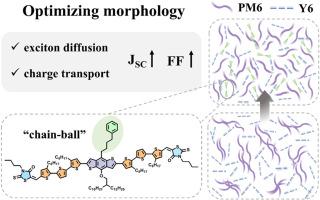Isomeric phenyl side chain based small molecule for optimizing morphology of ternary organic solar cells
IF 6.3
2区 材料科学
Q2 ENERGY & FUELS
引用次数: 0
Abstract
Optimizing morphology is essential to enhancing the performance of ternary organic solar cells (TOSCs). Incorporating a third component with suitable crystallinity and aggregation to regulate TOSC morphology proves to be an efficient method for improving device efficiency. In this work, two multifunctional donor small molecules with phenyl isomeric side chains, L1 (C4-Ph) and L2 (Ph-C4), are employed as guest components in the PM6:Y6-based ternary system. The impact of the phenyl positions in their molecular structures on molecular crystallinity, aggregation, and morphology of the TOSC is systematically investigated. The results indicate that the incorporation of 10 wt% L1 significantly improves the morphology of the blend film. Specifically, L1 disrupts the excessive aggregation of PM6 long-chain molecules, improves donor-acceptor compatibility, and reduces phase separation size in the active layer film. Exciton dissociation and charge transport in the active layer are promoted, and the final power conversion efficiency (PCE) increases from 15.97 % to 17.23 %. It is shown that the crystallinity and aggregation of the small molecule donor can be precisely regulated by the side-chain structure, which promotes its synergistic effect with the polymer donor. This approach provides an innovative idea for controlling the morphology of the active layer and improving the device performance.

基于苯基侧链的异构小分子优化三元有机太阳能电池的形态
优化形貌是提高三元有机太阳能电池(TOSCs)性能的关键。加入具有合适结晶度和聚集度的第三组分来调节TOSC的形态被证明是提高器件效率的有效方法。在这项工作中,两个具有苯基异构侧链的多功能供体小分子L1 (C4-Ph)和L2 (Ph-C4)被用作PM6: y6三元体系的客体组分。系统地研究了分子结构中苯基位置对TOSC分子结晶度、聚集性和形貌的影响。结果表明,加入10% wt% L1可显著改善共混膜的形貌。具体来说,L1破坏了PM6长链分子的过度聚集,提高了供体-受体相容性,减小了活性层膜中的相分离尺寸。活性层中的激子解离和电荷输运得到促进,最终功率转换效率(PCE)由15.97%提高到17.23%。结果表明,侧链结构可以精确调控小分子给体的结晶度和聚集,促进其与聚合物给体的协同作用。该方法为控制有源层形貌和提高器件性能提供了一种创新思路。
本文章由计算机程序翻译,如有差异,请以英文原文为准。
求助全文
约1分钟内获得全文
求助全文
来源期刊

Solar Energy Materials and Solar Cells
工程技术-材料科学:综合
CiteScore
12.60
自引率
11.60%
发文量
513
审稿时长
47 days
期刊介绍:
Solar Energy Materials & Solar Cells is intended as a vehicle for the dissemination of research results on materials science and technology related to photovoltaic, photothermal and photoelectrochemical solar energy conversion. Materials science is taken in the broadest possible sense and encompasses physics, chemistry, optics, materials fabrication and analysis for all types of materials.
 求助内容:
求助内容: 应助结果提醒方式:
应助结果提醒方式:


